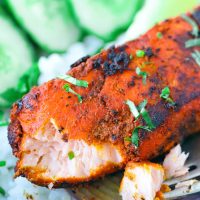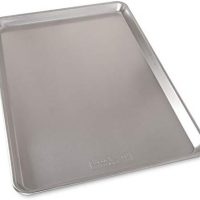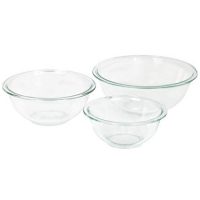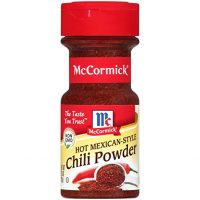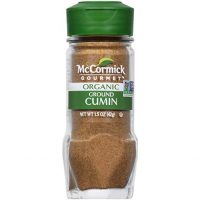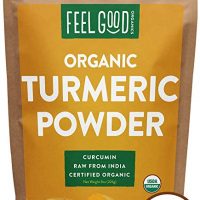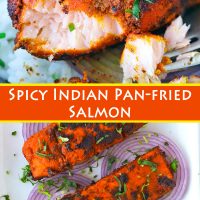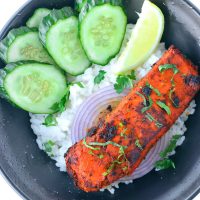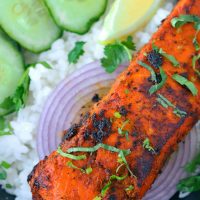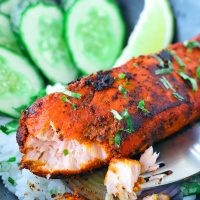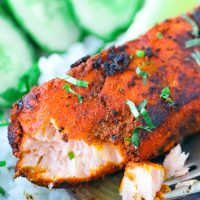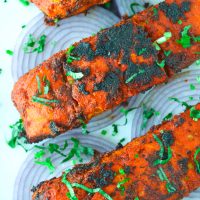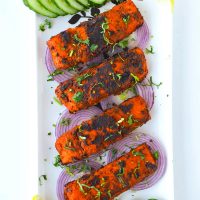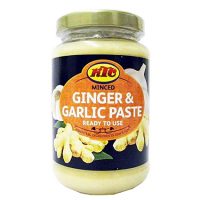 Buy Now →
Buy Now → Spicy Indian Pan-fried Salmon
This Spicy Indian Pan-fried Salmon is quick and easy to make, spicy, and ridiculously tasty! It’s loaded with flavor, and great for weeknight dinners and meal prep!
- Prep Time: 10
- Cook Time: 8
- Total Time: 18 minutes
- Yield: 4 1x
- Category: Dinner
- Method: Pan-fry
- Cuisine: Indian
Ingredients
Scale
- 4 Salmon Fillets, boneless, skin-on (about 120 grams/4–5 oz. per fillet)
- 2 TSP Kosher Salt (use half the amount if using iodized table salt)
- 3/4–1 TSP freshly cracked Black Pepper, to taste
- 2 TBLS Ginger Garlic Paste (use 1 TBLS of each if using separate bottles of ginger paste and garlic paste)
- 2 TSP Garam Masala (store-bought is fine, but I highly recommend using homemade garam masala for best flavor and taste)
- 1 TSP ground Cumin
- 1 TSP Coriander powder
- 1.5 TSP Turmeric powder
- 1 – 1.5 TSP ground Cayenne, to taste
- 1/2 – 1 TSP Chili powder, to taste (I used Mexican Hot Chili Powder, but Kashmiri or regular chili powder is good too.)
- 1/2 TSP Tandoori Color powder (you can use a drop of red food coloring instead, or leave it out since it’s only for color and won’t affect the taste)
- 2 TBLS freshly squeezed Lemon Juice
- 1 TBLS Water
- 2 TBLS Olive Oil (or any other cooking oil) – for frying
- To Serve (optional): Sliced red onion, sliced cucumber, lemon wedges, chopped coriander and/or mint leaves, a side salad, steamed rice, etc.
Instructions
- Clean the salmon fillets: Remove them from the packaging they came in and gently wipe with paper towels to dry them.
- Combine the salt, freshly cracked black pepper, ginger garlic paste, garam masala, ground cumin, coriander powder, turmeric powder, ground cayenne, chili powder, tandoori color powder, lemon juice, and water in a large mixing bowl. Mix with a spoon to evenly combine.
- Add the salmon fillets to the marinade bowl and use a spoon to spread and evenly coat the spice mixture on all sides of the fillets. Cover the bowl with cling wrap and set aside. Allow to marinate for 20 minutes at least, or overnight in the fridge for more flavor.
- Remove the salmon fillets bowl from the fridge 40-60 minutes in advance before cooking so that they can come to room temperature. (Note: Skip this step if marinating for less than an hour.)
- Heat the olive oil in a large nonstick skillet over medium-high heat. Lift the salmon fillets from the marinade bowl and allow any excess marinade to drip off. Once the oil is hot, place the salmon fillets skin side down in the skillet and pan-fry for 3-4 minutes. Then turn over the fillets using a fish spatula and pan-fry the front for 3-4 minutes. (You will notice the marinade blackening on the skin side, but don’t worry. The “burnt” bits will infuse the salmon with a charred and grilled flavor and can be scraped off after cooking as needed.) Use tongs or the fish spatula to turn and crisp up the sides of the fillets – about 15-20 seconds for each side. Once the salmon fillets have cooked through, transfer the fillets to a clean plate and scrape off any burnt bits if needed. (Note: Use a sharp knife to check the doneness of the flesh, or a meat thermometer to ensure that the internal temperature has reached 145°F/63°C*) Insert the knife or thermometer in the thickest part of the fillet. The flesh should be opaque and flake easily.)
- To Serve: Place the fillets on a plate lined with red onion slices, cucumber slices, and lemon wedges for squeezing if desired. Garnish with chopped coriander and enjoy with steamed rice and a side salad!
Notes
- How to tell if your salmon is cooked: The cooking time will vary depending on the thickness of your salmon fillets. The FDA recommends cooking salmon until it reaches an internal temperature of 145°F/63°C. I personally enjoy it at this temperature too. However, many people enjoy salmon when it’s cooked to medium – about 125-135°F (52-57°C). It is indeed flakier and more moist at this temperature. So feel free to cook it a couple of degrees under the FDA recommended temperature if that is your preference and at your own discretion. I highly recommend investing in a food thermometer if you want to make sure your salmon (or any other meat or fish you cook) is safe to eat.
- Baking instructions: Pre-heat your oven for 10 minutes at 400°F/200°C. Line a sheet of foil on a baking tray and brush lightly with olive oil or spray with cooking spray. One by one, lift the salmon fillets from the bowl and allow any excess marinade to drip off. Place the fillets skin side down on top of the foil. Slide the baking tray into the oven and bake for 10-15 minutes, or until the salmon fillets reach an internal temperature of 140°F/60°C. (They will continue cooking once out of the oven and will reach the FDA recommended temperature of 145°F/63°C.) Remove the pan from the oven and transfer the fillets to a serving plate lined with red onion slices, cucumber slices, and lemon wedges for squeezing if desired. Then garnish with chopped coriander, and serve with rice and/or a side salad and enjoy!
- Make ahead: This spicy Indian salmon is best enjoyed right after cooking, but you can cook it in advance and reheat in the microwave for a minute or two until heated through. Keep in mind that the fillets won’t be as crispy if you microwave them, and they may be a little dryer than if you were to eat it right after cooking.
- Meal prep: You can make this on a Sunday night for meal prep, and have the salmon with some salad and/or rice for dinner or lunch during the week. The spicy Indian salmon will still be incredibly tasty and flavorful on a Wednesday night even if you cook them on Sunday!
- Other ways to enjoy the salmon: You can enjoy the spicy Indian salmon in tacos, salad bowls, sandwiches (or burgers), wraps, etc. Or cut up the salmon into bite-sized pieces and enjoy with pasta, noodles, or on top of a naanza (naan pizza!).
Nutrition
- Serving Size: 1 salmon fillet
- Calories: 186
- Sugar: 2g
- Sodium: 748.8mg
- Fat: 6.1g
- Saturated Fat: 1.1g
- Unsaturated Fat: 2.3g
- Trans Fat: 0g
- Carbohydrates: 4.6g
- Fiber: 1.1g
- Protein: 27.2g
- Cholesterol: 61.2mg
Find it online: https://thatspicychick.com/spicy-indian-pan-fried-salmon/
